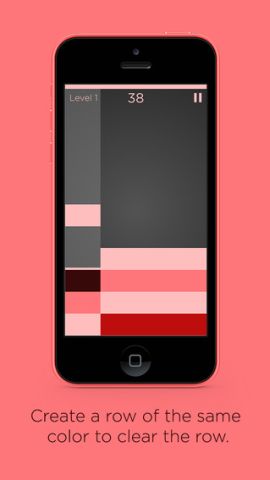
Lovers of puzzle games and easy-peasy mobile games will enjoy a fun new challenge with the recently released Shades, a puzzle game from Uovo that bears a resemblance to Tetris, except instead of using differently-shaped blocks, Shades requires players to consider the color of a series of rectangular blocks when placing them. The blocks are all uniform in size and shape; however, they are all different shades of one color (sort of like virtual paint swatches) which must be stacked to ultimately create rows of a single shade. Complete rows disappear, a la Tetris, and earn extra points as well as clearing the way for more blocks falling from the top, while like-shaded blocks stacked on top of one another meld together into a single block of the next darkest shade. Points accumulate through the placement of blocks, whether they blend into another shade, and when rows disappear.
Platforms: Android, iOS (Version Played)
Publisher: Uovo
Developer: Uovo
Genre: Falling Block Puzzler Without All Those Pesky Shapes
Release Date of Latest Update: April 10, 2015
iTunes App Rating/Android Content Rating: 4+ / Everyone
 Fast and easy to pick up, it isn’t always as simple as that. There are difficulty settings of Easy, Medium, and Hard, which correspond to how quickly blocks drop down. There is also an option to play with three, four (the default), or five columns. Even in Easy mode, which starts out slowly, blocks begin to fall faster as the levels increase and the columns grow higher, much like in Tetris. And if the initial slowness is, in fact, too slow for some players, the speed of individual blocks can be increased so that they descend more rapidly (helpful for the impatient among us). Tapping the screen designates which column a falling block will occupy, as well as controls the speed if one swipes it quickly down. Players are given a preview of the next shade in the top bar as one is falling, to better prepare and plan where blocks will go to blend and make whatever new shades of the color that are necessary. Each game uses only one color palette of about five shades; colors include green, purple, and red. If there are any more, I haven’t come across them yet.
Fast and easy to pick up, it isn’t always as simple as that. There are difficulty settings of Easy, Medium, and Hard, which correspond to how quickly blocks drop down. There is also an option to play with three, four (the default), or five columns. Even in Easy mode, which starts out slowly, blocks begin to fall faster as the levels increase and the columns grow higher, much like in Tetris. And if the initial slowness is, in fact, too slow for some players, the speed of individual blocks can be increased so that they descend more rapidly (helpful for the impatient among us). Tapping the screen designates which column a falling block will occupy, as well as controls the speed if one swipes it quickly down. Players are given a preview of the next shade in the top bar as one is falling, to better prepare and plan where blocks will go to blend and make whatever new shades of the color that are necessary. Each game uses only one color palette of about five shades; colors include green, purple, and red. If there are any more, I haven’t come across them yet.
 Strategy for earning points may vary: players may attempt to make rows of any shade so that they disappear, or may try to ultimately make all blocks the darkest shade possible so that the darkest rows disappear. It can be difficult to achieve entire rows of a single lighter shade because of the arbitrary order in which shades fall, so players may start out employing one method and end up using another or blending strategies, doing whatever they can at the time with the blocks they have. Often one must anticipate making a particular shade eventually, and have to place lighter blocks in a spot where they really rather wouldn’t, and hoping that they soon get the matching block needed to make the desired shades. Sometimes the shade needed comes up, and other times it’s like the line piece in Tetris, every shade but the one you need comes up. It’s always a bit of a disaster having to brick one shade into an inconvenient and unreachable island, where it may remain stuck for the rest of the game, like Fortunato in Poe’s The Cask of Amontillado. This occurs when darker shades fall on top of or surround lighter ones, trapping them. This may force blocks to get piled higher than they otherwise would have been, reaching a risky height. And once the blocks have reached the top of the screen with nowhere else to go, the game is over.
Strategy for earning points may vary: players may attempt to make rows of any shade so that they disappear, or may try to ultimately make all blocks the darkest shade possible so that the darkest rows disappear. It can be difficult to achieve entire rows of a single lighter shade because of the arbitrary order in which shades fall, so players may start out employing one method and end up using another or blending strategies, doing whatever they can at the time with the blocks they have. Often one must anticipate making a particular shade eventually, and have to place lighter blocks in a spot where they really rather wouldn’t, and hoping that they soon get the matching block needed to make the desired shades. Sometimes the shade needed comes up, and other times it’s like the line piece in Tetris, every shade but the one you need comes up. It’s always a bit of a disaster having to brick one shade into an inconvenient and unreachable island, where it may remain stuck for the rest of the game, like Fortunato in Poe’s The Cask of Amontillado. This occurs when darker shades fall on top of or surround lighter ones, trapping them. This may force blocks to get piled higher than they otherwise would have been, reaching a risky height. And once the blocks have reached the top of the screen with nowhere else to go, the game is over.
Reading that description, I think we can all agree Shades is basically Tetris without the pesky shapes to pay attention to. But similarities aside, it retains the challenging aspects of Tetris, and even mixes in other old favorites like Dr. Mario. Because players don’t have to deal with shapes, I find this easier to play when multitasking or tired. There must be some cognitive reason for that; I’m pretty certain our brains can more instantly recognize and handle different colors than different shapes. Isn’t that what the Stroop Effect proved? I don’t know, I’m not a neuroscientist. Someone tweet Mayim Bialik.
Anyway, I do love Tetris and other puzzle games, but sometimes one just wants to do something more relaxing and less anxiety-producing than Tetris can be sometimes. You know what I’m talking about… all the blocks so near the top, they’re falling rapidly, your brain has to decide in a nanosecond where to place them but alas! — you don’t even have a nanosecond, and then! Then it is all over.
Shades is easy to learn, fairly easy to master, and is recommended for the color-sighted of any age. Accomplished puzzlers (especially Tetris fans), mobile gamers, the easily anxious, shape-racists, and even potentially luddites will all enjoy this game.

Review Disclosure: A retail copy of Shades was purchased by Warp Zoned for the purposes of this review.







